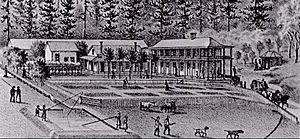Upper Soda Springs facts for kids
Upper Soda Springs is a special place located right by the Sacramento River in Dunsmuir, California, USA. It covers about ten acres of flat land on both sides of the river, plus the hills around it. The area also stretches north along the river to the Dunsmuir City Park. The State of California and the City of Dunsmuir are working together to create a new park at this historic spot.
This site is home to a beautiful riparian ecosystem, which means it's a natural area along a river. It also has its famous mineral water springs, which is where the name "Soda Springs" comes from. Because of its important location on the Siskiyou Trail, the history of Upper Soda Springs tells a lot about the history of California and the American West.
Contents
Early History of Upper Soda Springs
Before the big California Gold Rush started, no one lived permanently at Upper Soda Springs. The Okwanuchu tribe, who lived nearby, would use the area as a temporary camp, especially during the yearly salmon fishing season. Another local tribe, the Wintu, probably didn't have regular homes this far north along the Sacramento River.
First Visitors to the Springs
The first European or American visitors to this area were likely hunters and trappers. Groups from the Hudson's Bay Company, led by people like Michel Laframboise, came down from the Pacific Northwest in the 1820s and 1830s.
As early as the 1830s, a group of pioneers driving cattle, led by Ewing Young, stopped at Upper Soda Springs. They were traveling along what later became known as the Siskiyou Trail, going from Mexican-controlled California to settlements in Oregon. In 1841, a team of explorers from the United States Exploring Expedition, including mapmakers and plant experts, traveled through the upper Sacramento River canyon. They wrote about visiting mineral springs in the area, including Upper Soda Springs.
The Gold Rush Era and Beyond
When gold was found at Sutter's Mill in 1848, it started the California Gold Rush. Many people, called Forty-Niners, came to California looking for gold. Over the next ten years, these prospectors spread out from the original Gold Country in the Sierra Nevada mountains across the whole state. In 1851, gold was discovered near Yreka, California. This made many more people travel between California's Central Valley and Yreka, and even further north into Oregon and Washington.
A Stop for Travelers
People with mule trains, carrying supplies, joined the prospectors heading north. They followed old Native American foot trails through the rough mountains, including the Sacramento River canyon. The first permanent building at Upper Soda Springs was a simple place for these travelers to rest, built in the early 1850s. Around the same time, a group of Wintu people, who were trying to escape problems on the Trinity River, crossed the mountains and settled near the springs.
Developing the Resort
Around 1855, pioneers Ross McCloud and Mary Campbell McCloud built a toll bridge across the Sacramento River at the site. This meant travelers had to pay a small fee to cross. Over the next 30 years, the first stagecoach road between the Central Valley and Oregon passed through Upper Soda Springs. A larger inn was built, and a covered "springhouse" was added so people could easily enjoy the "soda water" from the mineral springs.
An interesting fact from this time: the name "Dolly Varden trout" was first given to a colorful local fish by Elda McCloud, the daughter of Ross and Mary McCloud.
When the Central Pacific Railroad arrived in 1886, the inn grew even more. It became known as the Upper Soda Springs Resort. Wealthy travelers from the Victorian era would come to "take the waters" at the mineral springs, believing they had health benefits.
However, as cars became popular in the 20th century, people's vacation ideas changed. The Resort closed around 1920. The land was then divided into smaller pieces and became private homes and businesses.
Upper Soda Springs Today
Starting in the late 1990s, people began working together, both publicly and privately, to buy back parts of the historic Upper Soda Springs Resort property along the river. These areas were then set aside to become park land. Some parts of the site have been cleaned up and restored, and more work is planned for the future.
Tauhindauli Park and Trail
Tauhindauli Park and Trail has been created along the beautiful Sacramento River canyon. It's located on the old site of the Upper Soda Springs resort in Dunsmuir, California. The park includes about ten acres of flat land by the river, the hillsides around it, and continues north along the eastern bank of the Sacramento River to the Dunsmuir City Park.
This spot has always been a favorite place for fishing and swimming. It's also important for its history and natural environment. Now, it has been improved to offer more fun activities and look even better. Environmental work and changes to the riverbanks have helped control floods for the whole town. This project has restored the river area, creating a natural park with paths that wind through native grasses and plants. You won't find perfectly mowed lawns here!
The park offers walking trails, places to fish, and picnic areas so everyone can enjoy the natural beauty of the Sacramento River. For the health of the environment and to help with floods, the forests and meadows along the river have been brought back close to their original condition. Riverbanks have been moved and built up to protect the park from river erosion and to restore the natural habitat that provides food for animals. You can get to the park from River Avenue to the south and from Stagecoach Road to Upper Soda Springs Road in the canyon.
Tauhindauli Park and Trail is a project led by the Dunsmuir Garden Club. Most of the money for this project comes from the Cantara Trustee Council and the Department of Fish and Game.


